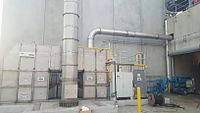
Photo from wikipedia
Ground vibration induced by blasting operations is an important undesirable effect in surface mines and has significant environmental impacts on surrounding areas. Therefore, the precise prediction of blast-induced ground vibration… Click to show full abstract
Ground vibration induced by blasting operations is an important undesirable effect in surface mines and has significant environmental impacts on surrounding areas. Therefore, the precise prediction of blast-induced ground vibration is a challenging task for engineers and for managers. This study explores and evaluates the use of two stochastic metaheuristic algorithms, namely biogeography-based optimization (BBO) and particle swarm optimization (PSO), as well as one deterministic optimization algorithm, namely the DIRECT method, to improve the performance of an artificial neural network (ANN) for predicting the ground vibration. It is worth mentioning this is the first time that BBO-ANN and DIRECT-ANN models have been applied to predict ground vibration. To demonstrate model reliability and effectiveness, a minimax probability machine regression (MPMR), extreme learning machine (ELM), and three well-known empirical methods were also tested. To collect the required datasets, two quarry mines in the Shur river dam region, located in the southwest of Iran, were monitored, and the values of input and output parameters were measured. Five statistical indicators, namely the percentage root mean square error (%RMSE), coefficient of determination (R2), Ratio of RMSE to the standard deviation of the observations (RSR), mean absolute error (MAE), and degree of agreement (d) were taken into account for the model assessment. According to the results, BBO-ANN provided a better generalization capability than the other predictive models. As a conclusion, BBO, as a robust evolutionary algorithm, can be successfully linked to the ANN for better performance.
Journal Title: Applied Sciences
Year Published: 2020
Link to full text (if available)
Share on Social Media: Sign Up to like & get
recommendations!